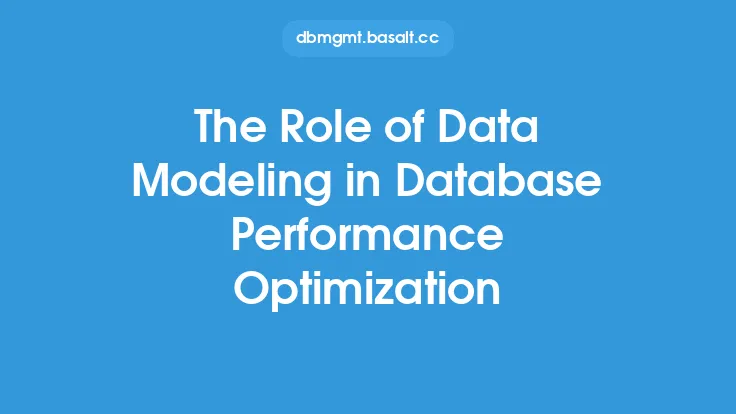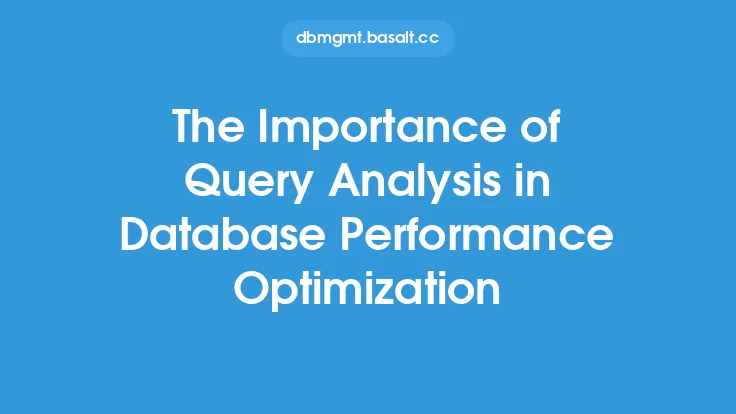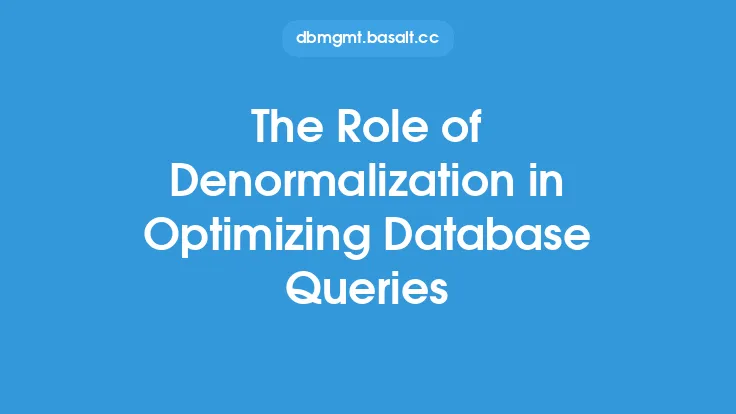When designing a database, one of the most critical aspects to consider is query optimization. Query optimization refers to the process of improving the efficiency of database queries to retrieve data quickly and effectively. This is essential because queries are the primary means of interacting with a database, and slow or inefficient queries can significantly impact the overall performance of the database. In this article, we will delve into the role of query optimization in database design, exploring its importance, key considerations, and best practices.
Introduction to Query Optimization
Query optimization is a complex process that involves analyzing and improving the performance of database queries. This can be achieved through various techniques, including indexing, caching, and rewriting queries. The goal of query optimization is to reduce the time it takes to execute a query, which can improve the overall responsiveness of the database and enhance the user experience. Query optimization is not a one-time task, but rather an ongoing process that requires continuous monitoring and refinement to ensure optimal performance.
Key Considerations in Query Optimization
When optimizing queries, there are several key considerations to keep in mind. First and foremost, it is essential to understand the query execution plan, which outlines the steps the database takes to execute a query. This plan can help identify performance bottlenecks and areas for improvement. Another critical consideration is the use of indexes, which can significantly speed up query execution by providing a quick way to locate specific data. Additionally, the database schema, including the structure and organization of tables, can have a significant impact on query performance. A well-designed schema can improve query performance by reducing the amount of data that needs to be scanned and processed.
The Role of Indexing in Query Optimization
Indexing is a crucial aspect of query optimization, as it can significantly improve the speed of query execution. An index is a data structure that provides a quick way to locate specific data within a table. By creating an index on a column or set of columns, the database can quickly locate the required data, reducing the need for full table scans. There are several types of indexes, including B-tree indexes, hash indexes, and full-text indexes, each with its own strengths and weaknesses. When designing an indexing strategy, it is essential to consider the types of queries that will be executed, as well as the distribution of data within the tables.
The Impact of Database Schema on Query Optimization
The database schema plays a critical role in query optimization, as it can significantly impact the performance of queries. A well-designed schema can improve query performance by reducing the amount of data that needs to be scanned and processed. This can be achieved through techniques such as normalization, denormalization, and data partitioning. Normalization involves organizing data into separate tables to reduce data redundancy and improve data integrity. Denormalization, on the other hand, involves combining data from multiple tables into a single table to improve query performance. Data partitioning involves dividing large tables into smaller, more manageable pieces to improve query performance and reduce storage requirements.
Best Practices for Query Optimization
To optimize queries effectively, it is essential to follow best practices. First and foremost, it is crucial to monitor query performance regularly, using tools such as query analyzers and performance monitors. This can help identify performance bottlenecks and areas for improvement. Another best practice is to use efficient query techniques, such as using indexes, caching, and rewriting queries. Additionally, it is essential to consider the database schema and indexing strategy when designing queries. By following these best practices, database administrators can improve query performance, reduce latency, and enhance the overall user experience.
The Importance of Query Optimization in Database Design
Query optimization is a critical aspect of database design, as it can significantly impact the performance and scalability of the database. By optimizing queries, database administrators can improve the speed and efficiency of data retrieval, reduce latency, and enhance the overall user experience. Additionally, query optimization can help reduce the load on the database, improving overall system performance and reducing the risk of downtime. By incorporating query optimization into the database design process, database administrators can create a high-performance database that meets the needs of users and supports business growth.
Conclusion
In conclusion, query optimization plays a vital role in database design, as it can significantly impact the performance and scalability of the database. By understanding the key considerations, including indexing, database schema, and query execution plans, database administrators can optimize queries to improve performance, reduce latency, and enhance the overall user experience. By following best practices, such as monitoring query performance, using efficient query techniques, and considering the database schema and indexing strategy, database administrators can create a high-performance database that meets the needs of users and supports business growth. As databases continue to grow in size and complexity, the importance of query optimization will only continue to increase, making it an essential aspect of database design and management.





